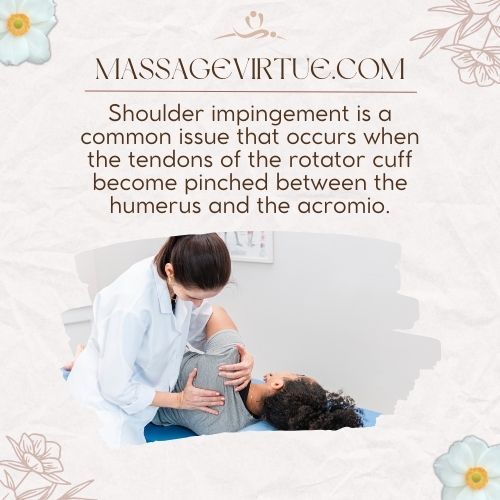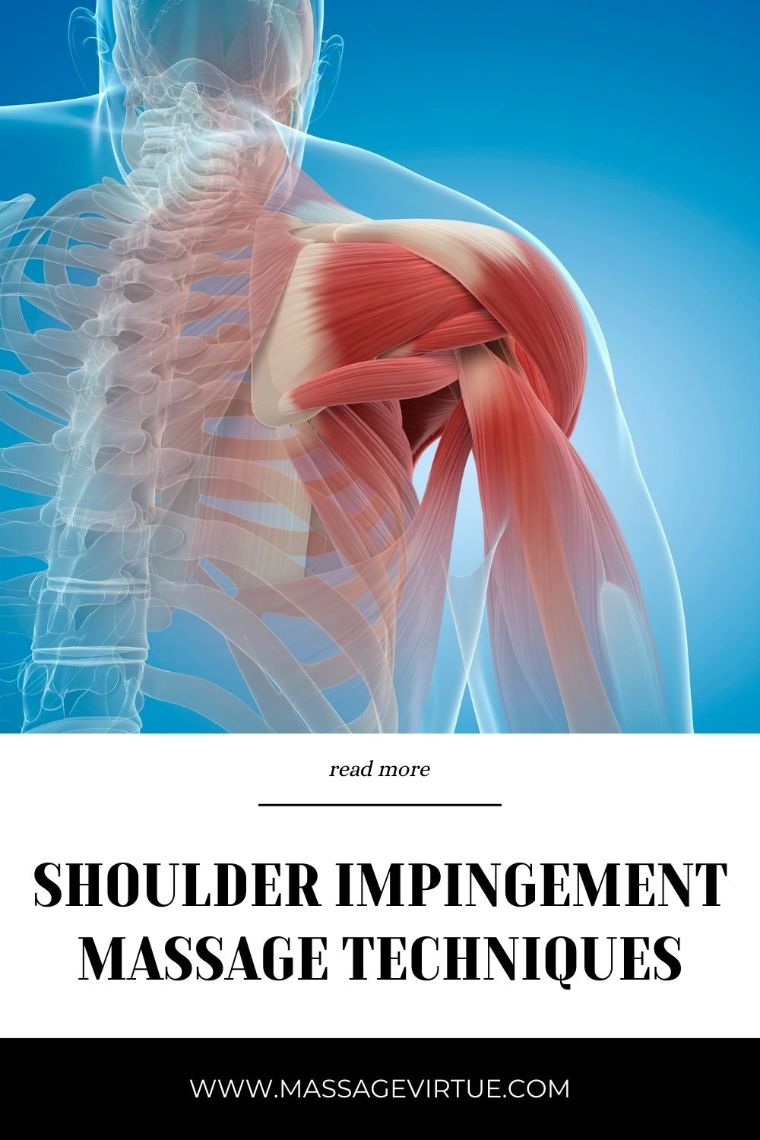Shoulder impingement can be a real pain – literally. If you’re one of the many individuals suffering from this condition, you know just how debilitating it can be.
The good news is that you don’t always need surgery or medication to find relief.
In this article, we’ll explore natural and effective shoulder impingement massage techniques that can help you alleviate discomfort and regain your shoulder’s mobility.
These techniques can be performed at home, making them accessible and cost-effective for those looking to find relief.
What is Shoulder Impingement?
Shoulder impingement, also known as shoulder impingement syndrome, is a common issue that occurs when the tendons of the rotator cuff become pinched between the humerus (upper arm bone) and the acromion (part of the shoulder blade).
This pinching usually happens in the subacromial space, which leads to pain, inflammation, and restricted movement.

The rotator cuff is a group of muscles and tendons responsible for stabilizing and moving the shoulder joint.
It comprises four key muscles: the supraspinatus, infraspinatus, teres minor, and subscapularis. When any of these components are affected by impingement, it can cause a lot of discomfort.
Shoulder Impingement Massage Techniques
Massage therapy can be a valuable tool in managing shoulder impingement. It helps to relieve tension, reduce inflammation, and improve blood circulation in the affected area.
Below, we’ll explore various massage techniques that you can perform at home to address shoulder pain and impingement.
1. Swedish Massage
Swedish massage is a gentle and relaxing technique that can help alleviate muscle tension in the shoulder area.
It involves long, flowing strokes and kneading motions that can promote blood flow and reduce discomfort.
How to do it:
- Sit or lie down in a comfortable position.
- Use a massage oil or cream for smooth movements.
- Apply gentle pressure using your fingertips and palms.
- Start with broad strokes, then focus on specific areas of tension.
- Perform for 15-20 minutes on each shoulder.
2. Deep Tissue Massage
Deep tissue massage targets deeper layers of muscle and fascia. This technique can be effective in releasing tension and breaking down adhesions that contribute to impingement.
How to do it:
- Apply firm pressure using your fingers, knuckles, or elbows.
- Focus on areas of pain and tension.
- Maintain slow, deep strokes.
- Be cautious not to overexert – it should be slightly uncomfortable but not painful.
- Spend 10-15 minutes on each shoulder.
3. Trigger Point Massage
Trigger points are tight knots within muscles that can refer pain to other areas.

By targeting these trigger points, you can reduce referred pain and discomfort in your shoulder.
How to do it:
- Locate trigger points in the shoulder area, often felt as small, tender knots.
- Apply steady, direct pressure using your fingertips.
- Hold the pressure for 30 seconds to 2 minutes or until the discomfort subsides.
- Repeat on different trigger points as needed.
4. Self-Massage Techniques
Self-massage allows you to have direct control over the pressure and areas you want to address. It’s particularly useful for individuals with shoulder impingement who may not have easy access to a massage therapist.
How to do it:
- Use a tennis ball or foam roller to apply pressure to your shoulder muscles.
- Roll the ball or roller over the affected areas.
- Adjust the pressure by controlling your body weight.
- Perform self-massage regularly to prevent tension build-up.
Common Trigger Points in the Shoulder Area
| Muscle | Trigger Point Location | Pain Referral Patterns |
| Supraspinatus | Top of the shoulder blade | Radiates down the arm |
| Infraspinatus | Back of the shoulder | May cause pain down the arm and hand |
| Teres Minor | Upper arm and shoulder | Radiates to the elbow and forearm |
| Subscapularis | Inside the shoulder blade | Pain can be felt in the chest |
Tips for Effective Self-Massage
- Start with gentle pressure and gradually increase it as your muscles relax.
- Focus on your breathing to help your body relax during the massage.
- Perform these techniques regularly for lasting benefits.
- If you experience severe pain or worsening symptoms, consult a healthcare professional.
Conclusion
Shoulder impingement can be a real obstacle to your daily life, but there are natural ways to find relief.
These shoulder impingement massages can be an essential part of your self-care routine.
Whether you opt for a gentle Swedish massage, deep tissue work, or trigger point release, you can make significant progress in reducing pain and regaining mobility.
Remember that consistency is key – regularly practicing these techniques at home can lead to long-term relief. If your symptoms persist or worsen, it’s advisable to consult a healthcare professional for further evaluation and guidance.
FAQs
Should You Massage a Shoulder Impingement?
Massage can be beneficial for shoulder impingement. It helps relieve muscle tension and improve blood flow, reducing discomfort.
However, it’s important to use gentle techniques and not massage too hard, as aggressive massage can make the condition worse. Consult a healthcare professional if you’re unsure about it.
How Do You Release Shoulder Impingement?
- Rest: Give your shoulder a break from activities that aggravate the pain.
- Physical Therapy: Work with a therapist for exercises that can help improve shoulder strength and mobility.
- Medication: Non-prescription pain relievers can help manage the discomfort.
- Ice and Heat: Apply ice for inflammation and heat for muscle relaxation.
- Posture: Maintain good posture to reduce strain on the shoulder.
What Are the Dos and Don’ts for Shoulder Impingement?
Dos:
- Do gentle shoulder exercises: Consult a physical therapist for suitable exercises.
- Use proper posture: Keep your shoulders back and down to reduce strain.
- Apply ice and heat: Use them as directed to manage pain and inflammation.
- Consider massage: But opt for gentle techniques.
- Stay consistent: Stick to your treatment plan and exercises.
Don’ts:
- Avoid overexertion: Don’t push through severe pain.
- Limit overhead activities: They can worsen impingement.
- Don’t slouch: Poor posture adds to the problem.
- Avoid aggressive massage: It can make the condition worse.
- Don’t skip rest: Rest is essential for healing.
What Worsens Shoulder Impingement?
Several things can worsen shoulder impingement:
- Overuse: Repeating overhead movements or heavy lifting.
- Poor Posture: Slouching or rounded shoulders.
- Aggressive Massage: Deep or hard massages on the affected area.
- Ignoring Pain: Not seeking treatment when symptoms arise.
- Muscle Imbalances: Weakness or imbalances in shoulder muscles.


